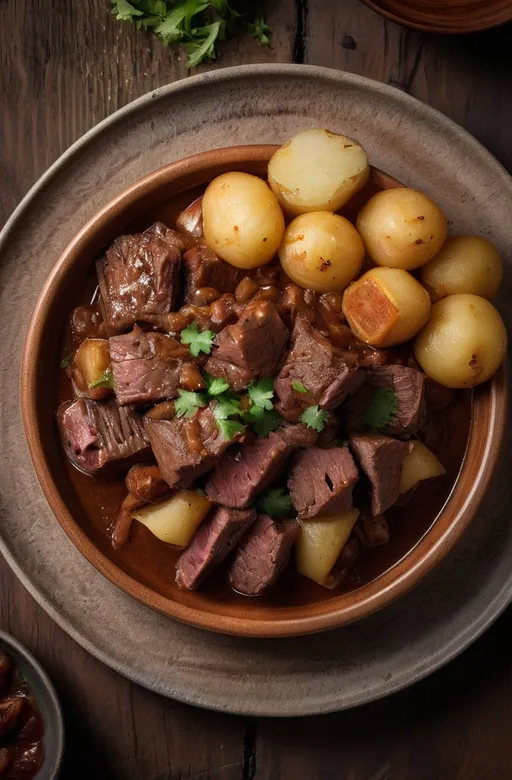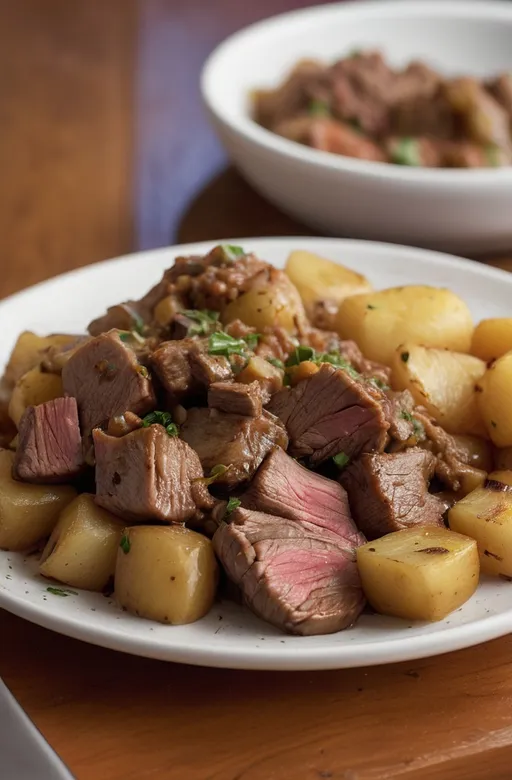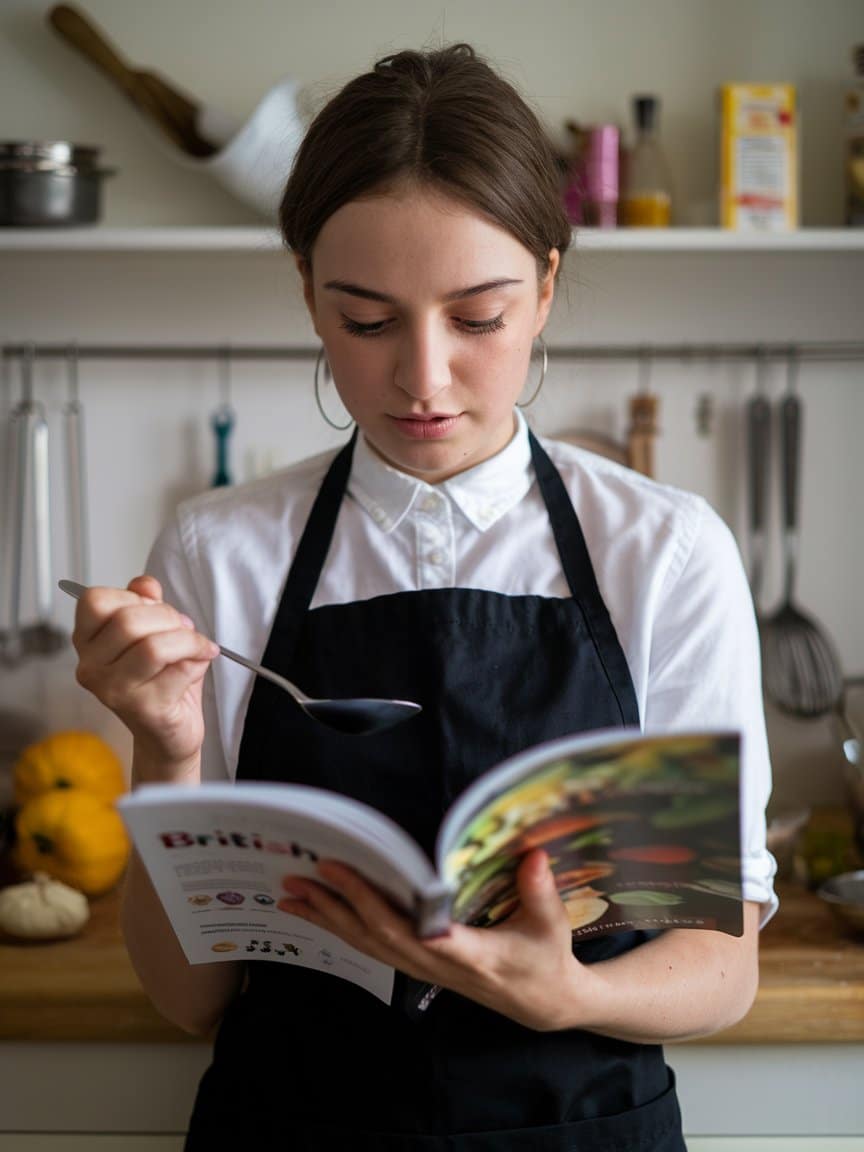There’s something magical that happens when beef simmers slowly with potatoes, absorbing a symphony of spices and transforming into a dish greater than the sum of its parts. The first time I tasted authentic Carne con Papas in a small family-owned restaurant in Miami’s Little Havana, I understood why this dish has survived generations. The tender beef practically melted, while the potatoes—having soaked up all those incredible flavors—delivered a comfort that felt like a warm embrace from an abuela you never knew you had.
Carne con Papas (literally “meat with potatoes”) might sound simple, but this Cuban classic represents centuries of culinary evolution and cultural fusion. It’s where Spanish cooking techniques meet Caribbean ingredients and African influences. The result? A hearty, soulful stew that has become a cornerstone of Cuban home cooking and diaspora communities worldwide.
What makes this dish truly special isn’t just its rich flavor profile but its accessibility. You won’t need fancy equipment or exotic ingredients to create something truly exceptional. Instead, Carne con Papas showcases how time, patience, and understanding of flavor development can elevate everyday ingredients into something extraordinary.
Focus Keywords
- Cuban beef stew
- Carne con Papas recipe
- Traditional Cuban cuisine
- Slow-cooked beef and potatoes
- Cuban comfort food
- Authentic Cuban stew
- Braised beef recipe
- Cuban family meal
- Latin American beef recipes
- Hearty potato and beef stew
Ingredients & Substitutions
For the Marinade:
- 2 lbs beef chuck roast, cut into 1-inch cubes
- 6 cloves garlic, minced
- 1 tablespoon dried oregano
- 1 teaspoon ground cumin
- 1/4 cup sour orange juice (naranja agria)
- 1/4 cup olive oil
- 1 teaspoon salt
- 1/2 teaspoon freshly ground black pepper
For the Cuban Beef Stew:
- 3 tablespoons olive oil
- 1 large onion, finely diced
- 1 green bell pepper, diced
- 1 red bell pepper, diced (optional but adds color)
- 4 cloves garlic, minced
- 1/2 cup dry white wine
- 1 cup beef broth (homemade preferred)
- 1 can (14 oz) crushed tomatoes
- 2 bay leaves
- 1 teaspoon dried oregano
- 1 teaspoon ground cumin
- 1/2 teaspoon smoked paprika
- 2 tablespoons tomato paste
- 2 lbs Yukon Gold potatoes, peeled and cut into 1.5-inch chunks
- 1/2 cup pitted Spanish olives (optional)
- 2 tablespoons capers, drained (optional)
- Salt and pepper to taste
- Fresh cilantro for garnish
The foundation of authentic Carne con Papas starts with the right cut of beef. Chuck roast works beatifully here—its marbling breaks down during long cooking, creating that melt-in-your-mouth texture we’re after in traditional Cuban cuisine. If chuck isn’t available, brisket or bottom round can subsitute nicely, though cooking times may vary slightly.
Sour orange juice (naranja agria) gives authentic Cuban dishes their characteristic tang. Can’t find it? Mix 2 parts orange juice with 1 part lime juice for a reasonable facsimile. The acidic component isn’t just for flavor—it helps tenderize the tough muscle fibers in the beef, essential for any good Cuban beef stew.
For the potatoes in this hearty stew, Yukon Golds offer the perfect balance of starch and waxiness. They’ll hold their shape while absorbing flavor, unlike russets which might disintegrate completely. Red potatoes can work in a pinch, but they won’t deliver quite the same creamy interior texture that makes Cuban comfort food so satisfying.
Step-by-Step Instructions for Authentic Cuban Stew

Marinating the Beef
- Combine all marinade ingredients in a large bowl or zip-top bag, ensuring the beef is well-coated. The marinade should have a thick, paste-like consistency that clings to the meat. Let this sit for at least 4 hours, but preferably overnight—this isn’t just about flavor, it’s bout breaking down collagen and connective tissue, a key step in any traditional Cuban beef recipe.
- When ready to cook, remove the beef from the marinade, reserving any liquid. Pat the pieces dry with paper towels—this is crucial for proper browning, as wet meat will steam instead of sear. Don’t skip this step; it’s the difference between mediocre and magnificent results in your Cuban beef stew.
- Let the meat come to room temperature for about 30 minutes before cooking. Cold meat hitting a hot pan causes uneven cooking and toughing of the exterior muscle fibers.
Preparing the Carne con Papas
- Heat 2 tablespoons of olive oil in a large Dutch oven or heavy-bottomed pot over medium-high heat until shimmering but not smoking. Working in batches (overcrowding is the enemy of good browning), sear the beef on all sides until deep golden brown, about 3-4 minutes per batch. Transfer browned beef to a plate and set aside. This browning step is essential for developing the rich flavor profile of authentic Cuban stew.
- In the same pot, add the remaining tablespoon of oil if needed. Add onions and bell peppers, cooking until softened, about 5 minutes. The vegetables will release moisture that helps deglaze the pan, incorporating all those flavorful brown bits (called fond) into your traditional Cuban dish. Add the garlic and cook for another 30 seconds until fragrant—garlic burns easily and becomes bitter, so always add it late.
- Pour in the white wine and use a wooden spoon to scrape up any remaining fond from the bottom of the pot. Let the wine reduce by half, concentrating its flavor while boiling off the alcohol. This step usually takes about 3 minutes and adds depth to your Cuban beef stew.
- Return the beef and any accumulated juices to the pot. Add beef broth, crushed tomatoes, bay leaves, oregano, cumin, paprika, and tomato paste. The liquid should barely cover the meat—not so much that it’s swimming, not so little that it’s dry. Stir to combine, bringing everything to a gentle boil.
- Reduce heat to low, cover, and simmer for 1.5 hours or until the beef is starting to become tender. You’ll know its ready for the next step when a fork meets slight resistance when piercing the meat. If your sauce seems thin, leave the lid slightly ajar during this cooking period. This slow-cooking process is what transforms this into a true hearty Cuban family meal.
- Add the potatoes, olives (if using), and capers (if using). Continue to simmer, covered, for another 30-45 minutes until both the beef and potatoes are fork-tender. The potatoes should be soft enough to squish with gentle pressure but still holding their shape—perfect for a classic slow-cooked beef and potatoes dish.
- Taste and adjust seasoning with salt and pepper. Remember that the flavors will continue to develop even after cooking, so be careful not to overseason. Remove bay leaves before serving your Carne con Papas.
When adding the potatoes, make sure they’re submerged in the liquid. If necessary, add a bit more broth or water—but only enough to barely cover them. The potatoes are cooking by both boiling and steaming in this preparation, essential for authentic Cuban stew texture.
Cooking Techniques & Science Behind Cuban Beef Stew

The magic of Carne con Papas happens through a series of chemical transformations that build layer upon layer of flavor. First, the acidic marinade begins breaking down tough muscle proteins in the beef, creating pathways for flavor molecules to penetrate deeper into the meat. Simultaneously, the salt performs its own tenderizing magic through osmosis.
Browning the meat (technically called the Maillard reaction) creates hundreds of new flavor compounds that didn’t exist before. This isnt just for color—it’s foundational to developing the complex flavor profile of traditional Cuban cuisine. When meat browns, amino acids and sugars in the protein recombine under heat to create entirely new molecules. That’s why properly browned meat tastes dramatically different from meat that’s been merely steamed.
The long, slow simmer accomplishes several things simultaneously, essential for any braised beef recipe. Collagen—the tough connective tissue in chuck roast—gradually converts to gelatin, giving the stew its silky mouthfeel and rich body. Meanwhile, fat renders slowly, distributing flavor compounds throughout the liquid. Additionally, water-soluble compounds from the vegetables leach into the broth, while fat-soluble flavors from herbs and spices dissolve into the beef’s rendered fat.
One crucial technique often overlooked in making hearty potato and beef stew: resisting the urge to stir too frequently. Each time you lift the lid, you release heat and extend cooking time. More importantly, excessive stirring breaks down the potatoes and meat, turning your beautiful chunks into something closer to mush. Gentle, occasional stirring is all that’s needed.
The Dutch oven (or similar heavy pot) plays a significant role too. Its thick walls maintain consistent heat distribution, while its tight-fitting lid traps moisture, creating a self-basting environment. If your pot has an ill-fitting lid, place a sheet of parchment paper between pot and lid to create a better seal—a tip professional chefs use when preparing Cuban comfort food.
Serving & Pairing Suggestions for Traditional Cuban Cuisine

Traditionally, Carne con Papas is served family-style with white rice on the side. The rice isn’t merely an accompaniment—it’s crucial for soaking up the flavorful sauce. A simple preparation of white rice with a bay leaf and a touch of olive oil complements without competing with your authentic Cuban stew.
For plating individual servings, place a mound of rice slightly off-center on each plate, nestling a generous portion of Carne con Papas alongside it. The sauce should pool slightly around both components. Garnish with fresh cilantro for brightness and visual appeal—the vibrant green provides beautiful contrast against the rich red-brown stew, making this Cuban family meal even more appetizing.
Accompaniments elevate this Latin American beef recipe from merely satisfying to truly memorable. Tostones (twice-fried plantains) offer textural contrast with their crispy exteriors and creamy centers. A simple avocado salad dressed with lime juice and olive oil adds freshness that cuts through the richness of the stew. For an authentic Cuban meal, serve with a side of black beans seasoned with oregano and bay leaf.
Wine pairings should stand up to the dish’s robust flavors without overwhelming them. A medium-bodied Spanish Tempranillo offers the right balance of fruit and structure, while a Cuban-style beer like a Vienna lager complements the hearty potato and beef stew’s savory profile perfectly. For non-alcoholic options, malta (a malt beverage popular in Cuba) or a hibiscus tea provide complementary sweetness.
Don’t forget the bread! Cuban pan de agua or a crusty French baguette is essential for sopping up every last drop of sauce. Slightly warm the bread before serving for maximum enjoyment of this Cuban comfort food.
For leftovers—which many argue taste even better the next day—consider transforming the Carne con Papas into empanada filling or serving it over toasted bread rubbed with garlic as a rustic tapa, extending the versatility of this classic Cuban beef stew.
Cultural Significance of Carne con Papas
Carne con Papas tells a story of cultural resilience and adaptation. Its roots trace back to Spanish colonization, adapting peninsular cooking techniques to available ingredients in the Caribbean. The dish evolved further through African culinary influences brought by enslaved peoples, creating something uniquely Cuban that has become central to traditional Cuban cuisine.

In Cuban households, this beef and potato dish often signals special family gatherings. The long cooking process traditionally brought family members into the kitchen to help prepare, chop, and stir, turning meal preparation into communal bonding time. For Cuban Americans and the diaspora community, Carne con Papas represents a tangible connection to heritage and homeland.
What’s particularly fascinating about this authentic Cuban stew is how it has remained remarkably consistent across generations while adapting to new environments. Cuban immigrants in Miami might add bell peppers not commonly used in the original island versions, while Cuban communities in Spain might incorporate local paprika variations.
Today, Carne con Papas serves as both comfort food and cultural ambassador. In restaurants from Miami to Madrid, it introduces diners to Cuban culinary traditions while providing expatriates with a taste of home. The dish exemplifies how Latin American beef recipes preserve cultural identity even when geographic connections are severed.
Conclusion
Mastering Carne con Papas isn’t just about following instructions—it’s about understanding the philosophy behind this quintessential Cuban beef stew. Patience rewards the cook as humble ingredients transform into something transcendent. The long marination, careful browning, and gentle simmer aren’t just techniques; they’re expressions of culinary wisdom passed down through generations of Cuban family meals.
What makes this traditional Cuban cuisine truly special is its accessibility coupled with its depth. Working with inexpensive cuts of meat and everyday vegetables, Carne con Papas demonstrates how proper technique elevates simple ingredients. It’s a reminder that great cooking often isn’t about rare components or complex methods, but rather about respecting food and understanding transformation.
Whether you’re exploring Cuban comfort food for the first time or reconnecting with cultural roots, Carne con Papas offers a delicious entry point into a rich culinary tradition. Its hearty, comforting nature speaks a universal language that transcends borders, bringing people together around the table—which, perhaps, is the true magic of this extraordinary slow-cooked beef and potatoes dish.
FAQs
Can I make Carne con Papas in a slow cooker or pressure cooker?
Absolutely! For slow cookers, follow the Cuban beef stew recipe through the browning stage, then transfer everything to your slow cooker and cook on low for 7-8 hours or high for 4-5 hours. Add the potatoes during the last 1-2 hours to prevent them from becoming mushy. For pressure cookers like an Instant Pot, brown the meat using the sauté function, add all ingredients except potatoes, and cook on high pressure for 35 minutes. Depressurize, add potatoes, and cook for another 5 minutes on high pressure. The texture will be slighty different from the traditional method, but still delicious.
My sauce is too thin—how can I thicken it?
If your authentic Cuban stew sauce lacks body, you have several options. The simplest is to remove the lid during the final 20-30 minutes of cooking, allowing excess moisture to evaporate. Alternatively, make a quick slurry by mixing 1 tablespoon of cornstarch with 2 tablespoons of cold water, then stir this into the simmering stew. For a more traditional approach, mash a few of the cooked potatoes and stir them back into the sauce—the released starch creates a natural thickener.
Can I prepare Carne con Papas ahead of time?
Not only can you, but you should! Like most hearty potato and beef stews, Carne con Papas benefits tremendously from resting overnight in the refrigerator. This allows flavors to meld and deepen while the texture of the meat continues to improve. Simply reheat gently on the stovetop before serving, adding a splash of broth if needed to adjust consistency. Many Cuban households purposely make this traditional Cuban dish a day ahead for special occasions.
What’s the best way to store leftovers?
Store cooled leftovers in an airtight container in the refrigerator for up to 4 days. The flavors of this Cuban family meal will actually improve over the first 48 hours. For longer storage, freeze portions in freezer-safe containers for up to 3 months. Thaw overnight in the refrigerator before reheating gently on the stovetop, adding fresh herbs just before serving to brighten the reheated Cuban beef stew.
Is there a vegetarian version of this dish?
While traditionalists might balk, you can create a delicious plant-based version using portobello mushrooms and/or jackfruit as meat substitutes in this Latin American recipe. Double the vegetables, use vegetable broth instead of beef broth, and add a tablespoon of soy sauce or miso paste for umami depth. The marinade works beautifully with these alternatives, and the long cooking process will still develop rich flavor. Some Cuban-American families have adapted similar vegetarian versions while maintaining the dish’s essential character and flavor profile of traditional Cuban cuisine.

Veronica is a passionate food enthusiast with over three years of experience in exploring and writing about diverse cuisines. Her expertise lies in reviewing restaurants, sharing creative recipes, and discovering the latest food trends. As the voice behind FoodieRecap.com, Anju brings fresh perspectives and culinary insights to her audience.
